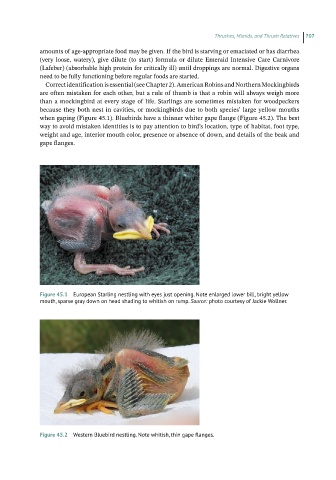Page 705 - Hand rearing birds second
P. 705
Thrushes, Mimids, and Thrush Relatives 707
amounts of age‐appropriate food may be given. If the bird is starving or emaciated or has diarrhea
(very loose, watery), give dilute (to start) formula or dilute Emeraid Intensive Care Carnivore
(Lafeber) (absorbable high protein for critically ill) until droppings are normal. Digestive organs
need to be fully functioning before regular foods are started.
Correct identification is essential (see Chapter 2). American Robins and Northern Mockingbirds
are often mistaken for each other, but a rule of thumb is that a robin will always weigh more
than a mockingbird at every stage of life. Starlings are sometimes mistaken for woodpeckers
because they both nest in cavities, or mockingbirds due to both species’ large yellow mouths
when gaping (Figure 45.1). Bluebirds have a thinner whiter gape flange (Figure 45.2). The best
way to avoid mistaken identities is to pay attention to bird’s location, type of habitat, foot type,
weight and age, interior mouth color, presence or absence of down, and details of the beak and
gape flanges.
Figure 45.1 European Starling nestling with eyes just opening. Note enlarged lower bill, bright yellow
mouth, sparse gray down on head shading to whitish on rump. Source: photo courtesy of Jackie Wollner.
Figure 45.2 Western Bluebird nestling. Note whitish, thin gape flanges.

